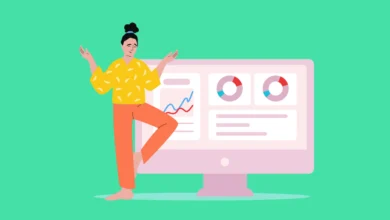First-Party Data and Privacy-First Marketing in 2025

Have you noticed how often your favorite apps now ask for permission? Whether it’s a cookie banner or a friendly “Can we use your data?” pop-up, it’s clear something big is changing. For marketers, the golden era of third-party cookies is winding down. And while it might feel like a roadblock at first, this shift is actually opening doors to smarter, more ethical, and more sustainable marketing practices. The key? First-party data.
In 2025, relying on third-party data feels a bit like using a paper map in a GPS world. It might get you somewhere, eventually, but it’s clunky, outdated, and unreliable. Meanwhile, first-party data, collected directly from your own audience, is becoming the engine that powers personalization, performance, and privacy all at once.
But how do you make the most of it? What does it really mean to build a privacy-first strategy? And is this just about compliance, or can it actually help you grow? In this guide, we’ll explore what first-party data is, why it matters more than ever, and how you can use it to future-proof your marketing.
What Is First-Party Data and Why It’s the Future of Marketing
Let’s keep things simple for a second. First-party data is information you collect directly from your audience, whether they’re browsing your website, signing up for a newsletter, filling out a quiz, or buying a product. It’s clean, reliable, and most importantly, it’s yours.
You might already be using it more than you think. Have a customer email list? That’s first-party data. Have analytics set up on your site showing how users behave? First-party again. Unlike data you rent from third parties, this is data you own, and that makes all the difference.
Declarative and Behavioral Data
First-party data typically comes in two flavors. Declarative data is what your users tell you. Think preferences, contact forms, or answers in a survey. It’s intentional and direct. On the other hand, behavioral data is what you learn by observing how they interact with your brand. Which pages they visit, how long they stay, what they click, this tells you just as much, sometimes even more.
When combined, these two create a powerful foundation. For instance, someone might say they’re interested in skincare (declarative), but your behavioral data shows they’re only clicking on sunscreen products. That insight alone can change the direction of your messaging, ad campaigns, and product suggestions.
Subscribe to our mailing list to get the new updates!
First-Party vs Second and Third-Party Data
Now let’s draw a line between what’s yours and what’s borrowed. Second-party data is essentially someone else’s first-party data, shared with you through a partnership. It can be useful, but you have less control and context. Third-party data, meanwhile, is aggregated from multiple sources, often without direct consent. This is the type of data that’s being phased out by browser changes and data laws, and rightly so.
Have you ever been served an ad that felt oddly specific… yet totally irrelevant? That’s often the result of low-quality third-party data. It’s outdated, misaligned, and honestly, a bit creepy.
Why It’s More Valuable Than Ever
Here’s the thing. First-party data isn’t just a fallback plan. It’s the foundation of marketing done right. It gives you clearer insights, helps you build stronger relationships, and keeps you on the right side of privacy regulations.
It also fuels personalization in a much more authentic way. You’re not guessing based on someone else’s metrics, you’re engaging with people who have actually interacted with your brand. And in a world where trust is currency, that matters more than ever.
Think about it: Would you rather talk to someone who’s been eavesdropping on your conversations, or someone you’ve willingly shared your preferences with? Your customers feel the same.
What’s Changing in 2024 and 2025 Privacy Rules and Platform Policies
Have you ever felt like the rules of digital marketing are changing faster than you can keep up? You’re not alone. Over the last few years, a wave of new privacy regulations and tech platform updates has transformed how marketers collect and use data. And this wave isn’t slowing down in 2025.
What’s driving it all? A combination of consumer demand for transparency, government regulation and tech giants adjusting their policies. Let’s break it down.
The Legal Landscape is Tightening
From Europe’s GDPR to California’s CCPA and Brazil’s LGPD, data protection laws have been reshaping marketing across the globe. In 2024, the Digital Markets Act (DMA) rolled out stricter rules for big platforms in the EU, especially around how user data is shared across services. Meanwhile, new drafts of ePrivacy regulations are floating around, and more countries are tightening their grip on data handling.
Even if your brand isn’t based in Europe or California, these laws can still apply if you’re serving users in those regions. That’s why understanding these frameworks isn’t just for lawyers anymore, it’s essential for marketers too.
Apple and Google Are Changing the Game
Remember when Apple launched App Tracking Transparency (ATT) and every app suddenly asked if they could track your activity across other apps and websites? That wasn’t a fluke. It was a turning point. Apple essentially gave users the steering wheel, and most chose to say “no thanks” to tracking.
Google followed suit. Chrome is phasing out third-party cookies, and the company is rolling out its Privacy Sandbox, a set of new tools that promise to preserve user anonymity while still enabling advertising. That might sound good in theory, but it also means marketers can no longer rely on the same signals they used to. Attribution becomes fuzzier, remarketing lists shrink, and audience targeting needs a rethink.
What This Means for Marketers
Let’s be honest, these changes are inconvenient at first. You might find it harder to build audiences, track conversions or prove ROI. But that doesn’t mean it’s all bad news.
These changes are also pushing the industry toward better, more respectful practices. Instead of chasing people across the web, we’re being encouraged to build deeper relationships with the audience we already have. And when you think about it, isn’t that what good marketing was always supposed to be?
So, what now? You can either try to fight the tide, or you can learn to surf. And surfing starts with knowing what kind of data you’re working with and how to use it in a privacy-conscious way.
How Privacy-First Thinking Changes Marketing Strategy
Let’s step back for a second. When you hear “privacy-first,” what comes to mind? For many marketers, it still sounds like a limitation , something that slows down growth, adds more friction, or kills creative flexibility. But in reality, shifting to privacy-first thinking doesn’t mean you have to become less effective. It just means you need to become more intentional.
From Silent Tracking to Clear Consent
Gone are the days when marketers could quietly collect user data in the background. Now, every cookie banner, preference center and opt-in form is a part of the user experience. If someone doesn’t trust your site, they won’t give you their data. And if they do, you’d better use it well.
This is where consent-first design comes in. It’s not just about compliance, it’s about creating a digital experience that feels transparent, respectful and rewarding. You can still collect data, of course. But the rules have changed. Now you need to offer value in return, explain clearly what you’re doing, and make it easy for people to say yes, or no.
Privacy and Trust Go Hand in Hand
Think of privacy not as a legal checkbox, but as a trust signal. When users feel like they’re in control, they’re more likely to engage with your brand. They might sign up for a newsletter, opt into SMS updates, or fill out a quiz that tells you more about their preferences. But that trust only comes if your intentions are clear.
Have you ever left a site just because it made you feel uneasy? Maybe there were too many pop-ups, or you weren’t sure what would happen to your data. That’s exactly the kind of experience privacy-first design avoids.
On the flip side, when a site makes it easy to understand what it collects and why, you feel safer. That feeling matters, and it has a real impact on conversion rates, customer loyalty and lifetime value.
Building a Strategy That Works for People
Privacy-first thinking isn’t just about what you can’t do anymore. It’s about what you can do better. You can create more meaningful touchpoints. You can personalize based on what people actually tell you. You can stop wasting spend on audiences that were never a good fit to begin with.
It also forces teams to work together more effectively. Legal, marketing, product, and engineering all need to collaborate. And while that can be messy at first, it leads to smarter systems, better segmentation and cleaner data in the long run.
So yes, privacy-first marketing takes work. But it’s not a roadblock. It’s a roadmap. And it’s one that puts your customers exactly where they belong, at the center of everything.
How to Build and Scale a First-Party Data Strategy
You don’t need to be a global brand with endless resources to build a strong first-party data strategy. You just need a clear plan, the right mindset, and a willingness to test and evolve. Whether you’re running a Shopify store, managing a B2B lead gen campaign or scaling an app, this part is for you.
Start With Consent and Build Trust at Every Touchpoint
Everything begins with trust. If your opt-ins feel forced, vague or manipulative, users will either leave or sign up and never engage again. So, let’s flip the script. Instead of begging for data, offer something valuable. That could be early access to a product, a helpful resource or even something as simple as a personalized recommendation.
The key is to be clear. Tell people what you’ll do with their information and stick to it. Don’t bury it in a privacy policy. Make it a part of the experience. And once they say yes, make it worth their while.
Unify Your Data Across Channels and Devices
Let’s say someone browses your website on mobile, signs up for your newsletter on desktop, and later purchases via your app. If you’re treating those actions as three separate people, you’re flying blind. Unifying data across touchpoints isn’t a nice-to-have, it’s essential.
This is where tools like Customer Data Platforms (CDPs) or well-integrated CRMs come in. They help you create a single view of the customer, allowing you to personalize more effectively, retarget accurately, and avoid redundant messaging.
Have you ever received the same welcome offer five times in a row? That’s a classic sign of disconnected systems. And it doesn’t exactly scream “we know you.”
Use Tools That Respect Privacy Without Losing Performance
The good news? You don’t have to choose between performance and privacy. Modern tools, like GA4, server-side tracking, and consent-based audience building, allow you to gather insights and optimize campaigns while respecting user choices.
For example, if you’re using GA4 properly, you can still see how people move through your site, what content drives conversions and where drop-offs happen. You just won’t be relying on creepy tracking pixels or third-party scripts.
If you’re running ads, platforms like Meta and Google now support first-party based custom audiences. That means your email lists, purchase histories and on-site behaviors can feed into powerful, privacy-compliant campaigns. But again, it all starts with the quality of your own data.
Segment With Purpose and Build Around Behavior
The beauty of first-party data is that it’s rich with intent signals. Someone who clicked a “notify me” button has a different mindset than someone who abandoned their cart. Your job is to read those signals and act on them.
But don’t overcomplicate it. Start simple. Segment by lifecycle stage, frequency of interaction, product interest or average spend. As your data matures, your segments will too. And the more relevant your messaging, the more responsive your audience becomes.
Here’s a personal tip: Don’t wait for perfect data to begin. You’ll always have gaps. Just start with what you know, test what works, and evolve as you go.
Create Value Exchanges That Encourage Opt-Ins
Let’s be honest, people are tired of giving away their email for a generic 10 percent off coupon. If you want them to share their data, give them a reason that feels personal.
Try things like interactive quizzes, product finders, exclusive content, or birthday perks. The more relevant the value exchange, the more enthusiastic the opt-in. This isn’t about tricking people into signing up. It’s about creating a relationship that feels mutual.
After all, would you rather hand your data to a brand that “just wants to keep in touch,” or one that says, “We’ll use your answers to tailor your experience, give you better offers and never spam you”?
The difference is everything.
How to Use First-Party Data in Real Campaigns
So, you’ve built up a solid base of first-party data. Now what? This is where things get fun. First-party data isn’t just for dashboards or email lists, it’s the fuel that powers smarter, sharper campaigns across every channel. Let’s walk through a few ways to actually put it to work.
Personalize Website Experiences and Messaging
You know those homepages that greet you with “Welcome back” or suggest items based on your last visit? That’s first-party data in action. By using past behaviors, like product views or time spent on a category, you can personalize not just content but layout, timing and even tone.
Imagine running an online bookstore. Someone who browses thrillers and adds Stephen King to their wishlist shouldn’t see cookbooks front and center on their next visit. A homepage tailored to their interests feels less like a storefront and more like a conversation.
Run Retargeting Without Relying on Third-Party Cookies
Retargeting is far from dead. It’s just evolving. Instead of relying on third-party cookies to follow users around the web, you can use your own data to build retargeting lists inside ad platforms like Meta, TikTok or Google.
Think email subscribers who haven’t purchased yet. Or cart abandoners who visited twice but didn’t convert. These are warm audiences you already have consent from. Uploading this data securely into ad platforms allows you to create custom audiences and even lookalikes, all without crossing any privacy lines.
Enhance Email, SMS and CRM Campaigns
Let’s say your email campaigns are getting decent open rates but not much else. First-party data can turn them into high-performance conversion tools. You can segment by purchase frequency, browsing behavior or even quiz results to tailor content.
A clothing brand, for instance, might send one version of an email to customers who love neutrals, and a bolder version to those who always click on prints. Same campaign, better targeting, better results.
SMS can work the same way. Short messages, timed right and based on actual preferences, feel helpful, not intrusive.
Build Loyalty Loops With Real Rewards
The best loyalty programs aren’t just about points. They’re about relationship-building. And first-party data helps you make each member feel seen.
For example, if you know someone shops once a month and always buys accessories, you can surprise them with a limited-time offer tailored to that behavior. Or if they haven’t shopped in a while, you can trigger a win-back campaign that doesn’t just say “we miss you,” but offers something they actually care about.
Measure Performance With Cleaner Attribution
Attribution has gotten messier, no doubt. But first-party data makes it more manageable. By tracking customer journeys within your ecosystem, on-site activity, email clicks, purchase history, you get a much clearer picture of what’s working.
You might not have every click across the internet, but you have enough to understand what influenced a conversion and where to invest next. And since the data is coming directly from your channels, it’s far more reliable.
What Not to Do Common Pitfalls to Avoid
By now, it might feel like first-party data is the answer to all your marketing problems. And while it is powerful, it’s not magic. Just collecting data doesn’t guarantee results. How you use it, and avoid misusing it, makes all the difference.
Let’s look at a few traps many brands fall into when building a first-party strategy.
Collecting Data Without a Clear Purpose
One of the most common mistakes is gathering too much information without knowing what to do with it. Just because you can ask for someone’s birthdate, favorite color or pet’s name doesn’t mean you should.
If the data doesn’t directly improve their experience or your ability to serve them better, it adds clutter. Worse, it may reduce trust. People can sense when their data is being collected “just in case.”
Ask yourself this: “If I collect this, how will I use it in a way that benefits both sides?” If the answer isn’t clear, skip it.
Creating Silos Between Teams and Tools
Let’s say marketing is collecting email data, product is tracking in-app behavior, and support is logging customer complaints. But none of these systems talk to each other. That’s a silo, and it can kill the potential of your data.
Customers expect consistent, seamless experiences. They don’t care which department is responsible for what. If one hand doesn’t know what the other is doing, your campaigns will feel fragmented.
Invest in unification early. Choose platforms that integrate well, and create workflows where teams share insights instead of hoarding them.
Forgetting About Compliance and Transparency
Even when your intentions are good, it’s easy to misstep on compliance if you’re not careful. Are you storing data securely? Are you making it easy for users to opt out or edit their preferences? Are your consent forms written in plain language?
Being compliant doesn’t mean being boring, it means being respectful. Make privacy a part of your user experience, not a scary legal page buried at the bottom of your site.
Transparency builds trust. And trust, over time, builds loyalty.
Segmenting Too Much and Acting Too Little
Here’s another trap: over-segmentation. It’s tempting to create dozens of audience groups with hyper-specific traits. But if you don’t have the resources or bandwidth to tailor messaging for each one, the effort is wasted.
It’s better to act on a few high-impact segments than spread yourself thin trying to personalize everything. Let your strategy grow with your team’s capacity. Start small, and scale what works.
First-Party Data Examples From B2C and B2B Brands
It’s one thing to talk about strategy. It’s another to see it in action. Whether you’re running an online store or a B2B software company, first-party data has the potential to make your campaigns smarter, more personal and more effective.
Here are two real-world-style examples that bring it to life.
B2C Example The Slipper Store That Stopped Guessing
Imagine an e-commerce brand that sells slippers. At first, their marketing relied on seasonal promotions blasted to the full mailing list. Sales were inconsistent. Engagement was low. Returns were high. Sound familiar?
They decided to introduce a simple quiz on their homepage: “What kind of slipper suits your lifestyle?” Within minutes, users were answering questions about foot warmth, indoor habits and fabric preferences. With that information, the store began segmenting users based on comfort needs.
Now, instead of a generic winter sale, customers received emails with product suggestions like “Our warmest slipper yet for people who hate cold tiles” or “Machine-washable picks for busy parents.” Open rates jumped. Conversion rates doubled. Returns dropped.
None of that would have been possible with third-party cookies. But by collecting insights directly, and using them with care, the brand transformed its messaging from generic to genuinely helpful.
B2B Example The Software Vendor That Got Specific
Now let’s talk B2B. A SaaS company offering applicant tracking software had plenty of traffic to its blog, but not enough demo requests. They decided to start small.
First, they added lead magnets tailored to specific buyer personas: HR managers, recruiters and startup founders. Instead of just one download, each visitor saw a resource relevant to their job role.
Second, they tracked content engagement on the site to see what topics users were reading. If someone read three articles about “remote hiring,” the team added them to a segment for remote-first companies.
The result? Email follow-ups with remote hiring case studies, personalized demo invites and even custom pricing pages that matched their use case. Suddenly, a generic lead became a qualified prospect, with context that helped the sales team close faster.
This wasn’t about trickery or aggressive remarketing. It was about listening to what users were saying through their behavior, and responding in kind.
What Comes Next The Move Toward Zero-Party Data and Predictive Personalization
First-party data is just the beginning. As marketers adapt to a privacy-first world, there’s a new layer of insight gaining traction: zero-party data. It’s even more direct, even more intentional and, when used correctly, remarkably powerful.
So, what’s the difference?
Zero-Party Data Is Freely Given, Not Inferred
Unlike first-party data, which you collect through behavior or transactions, zero-party data is explicitly shared by the user. Think of a customer who fills out a style quiz, sets product preferences, or chooses what kind of content they want to receive.
It’s proactive. It’s voluntary. And best of all, it’s accurate.
You’re not guessing based on clicks or time-on-page. You’re working with declared intentions. That clarity can dramatically improve everything from product recommendations to email copy.
Have you ever taken a quiz that nailed your taste perfectly, then kept engaging with the brand just because it felt like they “got” you? That’s zero-party data in action.
Interactive Tools Make It Scalable
The key to collecting zero-party data isn’t more forms. It’s experiential content. Try things like:
- Product finders
- Onboarding flows
- Preference center
- Loyalty profile setups
These tools turn data collection into something that feels less like a transaction and more like a service.
Of course, you still need to use this data responsibly. But when customers feel in control, and see immediate value, they’re often happy to share.
Predictive Personalization Without Compromising Privacy
As machine learning becomes more accessible, predictive personalization is on the rise. But here’s the catch: it only works if your foundation is clean, compliant and respectful.
Rather than scraping the web for signals, smart brands are feeding their AI with permission-based first and zero-party data. This allows you to anticipate user needs and deliver timely messages, without crossing any ethical or legal lines.
Let’s say a user typically buys skincare products every six weeks. You don’t need a third-party tracker to remind them, it’s already in your system. Add a predictive layer, and you can send a gentle nudge right before they run out.
Done well, this feels like magic. Done poorly, it feels invasive.
Privacy Becomes a Differentiator
In 2025, showing that you care about privacy isn’t just about avoiding penalties. It’s a brand asset.
Customers are choosing brands that are clear, respectful and transparent. They’re turning away from the ones that hide behind jargon or manipulate consent.
By embracing privacy-first strategies, you’re not only building better systems, you’re building trust. And trust, in this environment, is priceless.
Final Thoughts Take Ownership of Your Data Future
Let’s face it. The old way of doing digital marketing, relying on third-party cookies, endless tracking scripts and vague audience data, is fading fast. But that’s not a loss. It’s an opportunity.
First-party and zero-party data aren’t just about compliance. They’re about building better relationships. When someone shares their preferences with you, it’s a sign of trust. When they engage with your site repeatedly, that’s a sign of loyalty. These aren’t just signals to be harvested. They’re bridges to be strengthened.
If there’s one message to take away from all this, it’s that you need to own your data strategy. Not rent it. Not borrow it. Own it. From the way you collect consent to the way you personalize your campaigns, every part of the experience is a reflection of your brand.
Start small if you have to. Run an audit of what data you already collect. Review your opt-in forms. Talk to your team about how different departments handle customer information. You don’t need a perfect system overnight. You just need progress, and the mindset to keep evolving.
Because here’s the truth: marketing is no longer about who can shout the loudest. It’s about who can listen the best.
And if you listen closely, your customers are already telling you everything you need to know.
Wanna see how your website perform?
Let's run a comprehensive technical SEO audit for your website and share a compelling SEO strategy to grow your online business.
SEO Audit →


